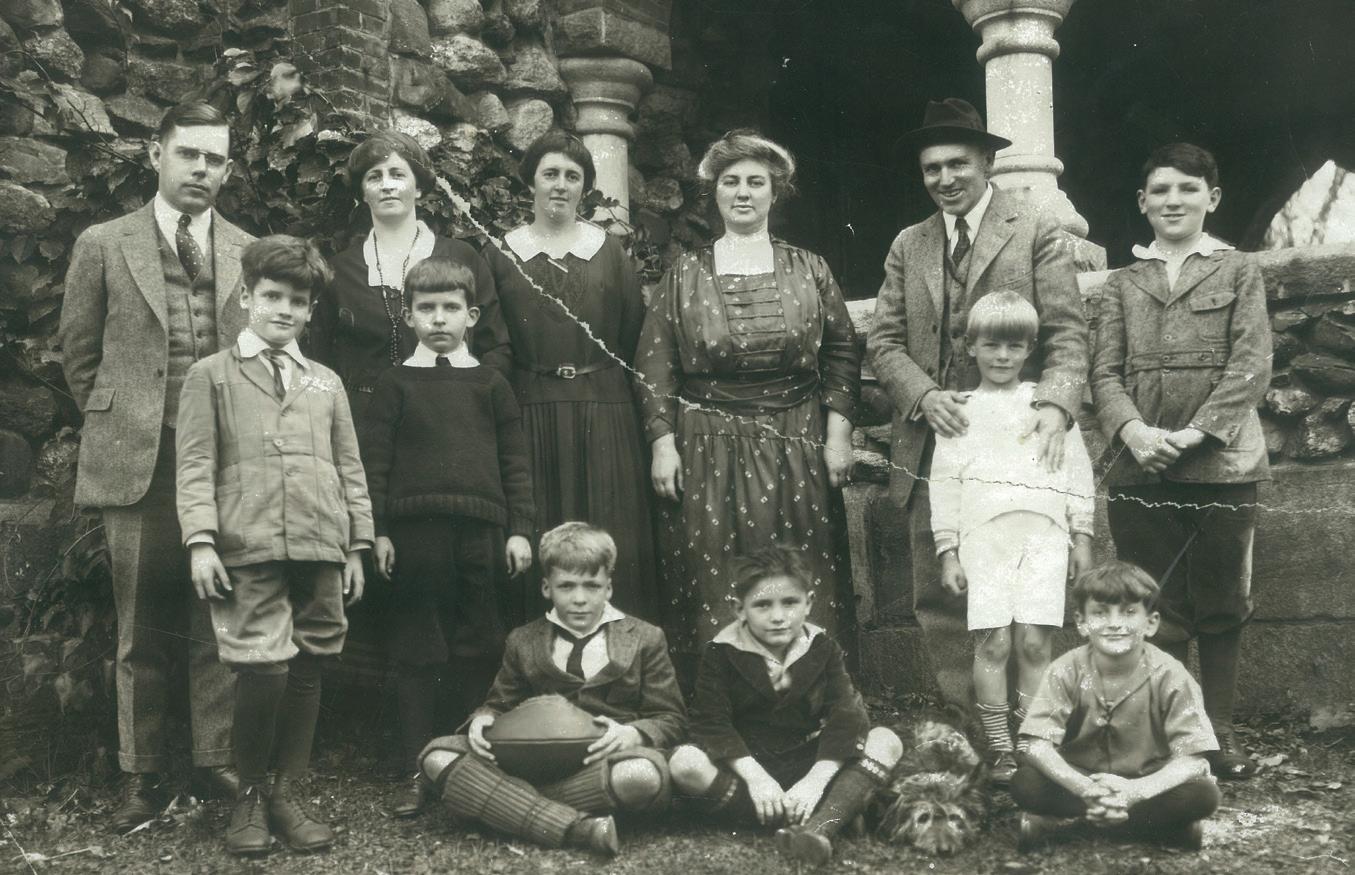
6 minute read
An Ever-Abiding Faith
The headmasTer’s View
Rev. Frank H. Bigelow, Headmaster 1920–1937
Welcoming first student George Chandler Holt II in 1920 into their home, the rectory of Christ Memorial Church, altered Frank and Mabel Bigelow’s life course— what had been a wishful desire to found a small preparatory home school for boys became an everyday reality and their calling. An Episcopalian priest, Father Bigelow served as headmaster of Rectory School from 1920 to 1937 alongside his wife, affectionately called “Mother Bigelow.” As co-founders, Frank and Mabel’s complementary roles are aptly illustrated in George Holt’s remark upon the School’s 20th anniversary: “Father Bigelow taught us and Mrs. Bigelow brought us up!’ In Father Bigelow’s own words through his writings in the school’s newspaper, The Rectory News, one comes to understand his enduring beliefs and the founding spirit of the School—a devotion to a life of service; a personalized focus on the individual student within the context of supporting the values of community; the benefits of serious and structured study; the necessity of play, nature, and the outdoors; and, ultimately, the conviction of his ever-abiding spiritual faith.
Looking over the group of boys at Rectory this year, both old and new, Mrs. Bigelow and I are sure that this will be one of our happiest years. With three [returning] boys as prefects…and with some of our little boys developing into older ones every year, we see the school developing a real foundation. (Fall 1930) I am more and more convinced that about all a school can do for a boy scholastically is to provide an atmosphere in which study can be done and teachers who will sympathetically and as wisely as they can, help the pupil to do it. … In our upper school study should be taken seriously as it is the main business, after all, of a school. To a high standard of work and achievement then, I will call our upper forms and ask the cooperation of parents, teachers and boys to that end. (December 1929) …Education will develop powers of concentration and mastery of subject matter more than sufficient to pass certain bare outlines of requirements, if it has time, but real education is living and thinking and in the largest sense human. (February 1931) This year, I am giving much of my time to scholastic and other problems of individual boys, our educational program has been made as elastic as possible, and I shall be glad to hear directly from any parent in regard to a boy’s particular case, as I am keeping very closely in touch with each boy, and desire his success in every relationship. (November 1931) The boys and masters are now like old friends. We are an organism, a social group, rubbing against each other, occasionally irritated, often frustrated, but succeeding in spite of it all in building some intangible but real cohesion of spirit, aim, and objection. The real end of any living thing is to live—and unless the school is alive, it fails even though it functions perfectly as an educational factory, in which children go through the listless motions of apparent learning with an eye on the clock, and an ear for the bell. I think that we are alive with vital interests which have really seized some boys amongst us, and unconsciously perhaps affected us all. (December 1931) In the education of a boy the unconscious influence of natural surroundings can be greatly undervalued. Not the building, but where the buildings are is the question. To be in Pomfret is to be ministered to by a friendly, all the year-round beauty. Nature has no flamboyant attitudes…From our low and glacier-smoothed hills we look off in a December hush at softened, glowing skies, or are blown by tempestuous winds or driving rain with almost equal pleasure.
“All for each and each There seems to be in December an Advent stillness. We expect that January will be cold. for all” should be the motto of We hope for skating and snow. Will Nature fail a school, because it is the secret to do her part to amuse the boys? But whatever comes, we love Pomfret and all her humours, for of a happy, wholesome, and she is the most interesting, the most engaging fruitful school life.” and the most permanently effective teacher that we have. (December 1932) It is the age of the so-called “gang spirit.” The word has a sinister significance. The gang and the gangster suggests secretiveness, cruelty, callous disregard of social rights, and lawless activities. But the gang has wonderful potent possibilities. The gang may be the school. It may mean loyalty to the whole group, and the subjection of the less desirable activities of the one for the good of all. And this is highly desirable to supply balance where, as we believe justly, we lay so much emphasis upon the individual…Each of us must develop the best he has in him, must be a real and significant person to add color and strength to the whole group and to contribute to the “good life”. “All for each and each for all” should be the motto of a school, because it is the secret of a happy, wholesome, and fruitful school life. In my experience I have never known one who was loyal to the school and who worked unselfishly for its good because he realized his privileges as a member, who did not enrich his own personality. The saddest person in the world is the one who always thinks of what he can get, never gives, and finds that he has lost
Faculty and students in front of Christ Church rectory, c. 1922. BACK ROW: Rev. John Rooney (teacher and rector), Mrs. Eleanor Bennett (art and handwriting), Miss Annie Ash (music), Mrs. Mabel Bigelow, Rev. Frank Bigelow, John Bigelow. MIDDLE ROW: Frederick or George Bartter, Benjamin Grosvenor, Peter de Florez. FRONT ROW: Herbert Seeley, unidentified, Junior Seagle

everything. Let us be good gangsters and realize that each person in the school is a member and so should have our loyalty, protection, and help. (October 1933) Speaking for myself, I believe that one of the famed “R’s” is fundamental. To be able to read at an early age, with reasonable speed, ease, and comprehension, is to have placed in one’s grasp a key to knowledge, culture, and power—yes and to happiness incomparable… The second “R” is important. Here at Rectory the boys are expected to write to their parents on Wednesdays and Sundays. One of these letters is supervised. The purpose is a laudable one. It is an effort to induce these boys to present one letter of reasonably “neat” appearance, with a minimum of misspelled words and a legibility which will not require the length of time necessary for the average crossword puzzle to decipher…To write legibly, to spell accurately, and to observe those rules of spacing, punctuation, and other niceties of letter writing and at the same time to think of something to write about, is after all a real test for many of us. (December 1935) The School now is established…For the good will of friends, the confidence of parents, especially of those whose boys entered the school [at its beginning] and have been with us ever since, we are deeply grateful…Our chief reliance has been upon the boys themselves. They were and are the School. God bless them. Our love to them wherever they are. They are welcome here always, and we are happy when they send us news of their comings and goings. (1928) I would be happy to hear from all of them, and especially to have them feel that there is always a warm welcome for them here at Rectory. (Fall 1930) 1921–1922 Directory Faculty

Rev. Frank Bigelow Mrs. Mabel Bigelow Rev. John Rooney, Rector at Putnam Miss Annie Ash, Music Mrs. Bennett, Art & Handwriting Boarding Students
George Holt John Bigelow
Phillip Ward Herbert Seeley
Junior Seagle Charles Crump Frederick Bartter George Bartter Kenneth Bell
Day Students Ruth Palmer Florence Grosvenor Ben Grosvenor Peter de Florez

